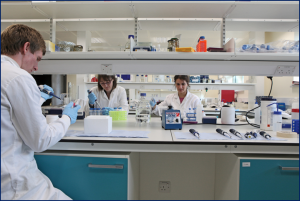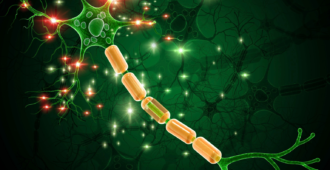In the Sheffield Institute for Translational Neuroscience (SITraN), the gene therapy group led by Prof Mimoun Azzouz is approaching the final stages of preclinical development of a treatment for Spinal Muscular Atrophy (a childhood disease of the motor neurones). Here Chris Binny explains more about the group’s work.
About Spinal Muscular Atrophy
Spinal muscular atrophy (SMA) is an inherited disease affecting between 1/6,000 and 1/10,000 newborns. These patients have inherited two faulty copies of the SMN1 gene and, as a result, can’t make enough of the protein “survival of motor neuron” or SMN. This causes the gradual loss of motor neurons, causing progressive muscle weakness and paralysis beginning in the lower legs and spreading upwards over a period of months or years.
In SMA Type 1, the most common and most severe form, babies never develop the muscle strength to sit unsupported, and are unlikely to live for longer than two years. Patients with SMA Types 2, 3, and 4 show later onset of disease, ranging from early childhood to full adulthood, and with medical care and suitable assistive devices such as powered wheelchairs can have decades of life after symptoms start to appear. Currently, no treatments are available to prevent or slow disease progression in affected patients.
Gene therapy
The aim of this project is to prevent the onset of this disease, by delivering a healthy copy of SMN1 to a patient’s motor neurons, keeping them — and therefore the patients — healthy. First, we modified (codon-optimised) the coding region of the SMN1 gene, to express its protein more efficiently. With this accomplished, we packaged the gene into a modified virus, AAV9, which has the natural ability to infect humans without causing disease, and to reach our targeted cells, the spinal motor neurons.
We first confirmed that a single, intra-venous injection of this virus to mouse pups resulted in long-lasting expression of SMN protein in their spinal motor neurons. Encouraged by this, we then tested the ability of a single dose of our virus to actually treat the disease. In mice which develop SMA type 1 (the SMNΔ7 model) and have a typical life expectancy of 12 days, we have demonstrated that a single treatment with our vector dramatically improves their symptoms and survival. At our most effective dose, the median survival increased more than tenfold, with the longest-lived animal surviving for over a year. These rescued animals are alert, lively, and socialise well with their littermates throughout their lives.
Clinical trials
Based on these successes treating SMN in animals, we are now preparing for the transition to a clinical trial using our therapeutic virus. We’ve established our large-scale manufacturing process, and over the coming months our pilot batches will be tested in formal toxicology and stability studies. In the meantime, we’re working with experts from around the world to finalise our plans for a safe and effective clinical trial of our therapy. One of SITraN’s key goals is to foster an environment supporting projects from “basic” research into the fine molecular details of disease, through to clinical trials and beyond; we’re excited at our project’s steady progress along that pathway from the lab bench to the clinic.







how long to patient???????????
very very good
As a sufferer of SMA type 4 I was very interested in this article. I contacted my neurologist at the QE Birmingham at the time this was first posted in 2014 , to ask him to investigate the possibility of me becoming involved in any treatment or trial, but he said he had tried to contact the people carrying out this project to see if there was a possibility for me to be considered but had never received a reply. It is a shame things are put on sites but there is no chance any follow up.
Hi David
Thank you for your comment. As we are not involved with SMA research we are not up to date with the status of this trial. Perhaps the SMA trust may have further information? The SITraN website had an announcement last autumn on SMA funding but it did not specifically refer to Prof Azzouz’s SMA clinical trial progress.
Kind regards,
Sara Bolton
MND Association, UK